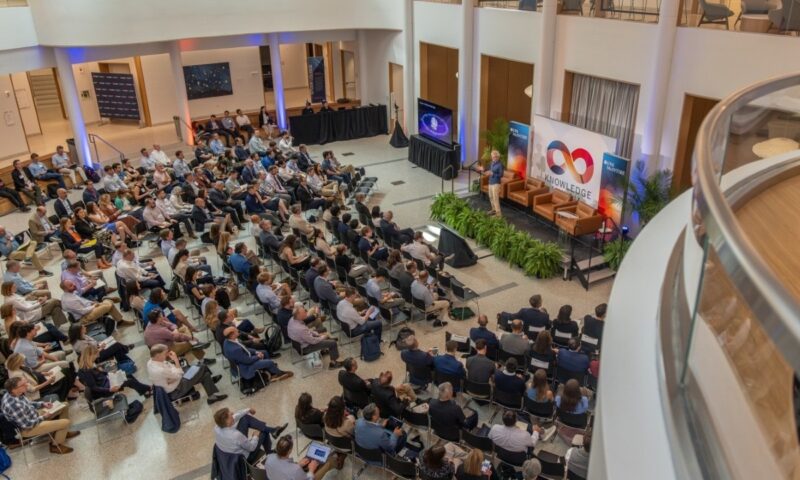
Paul Daugherty
As the leader of Accenture’s AI initiatives, Paul Daugherty, the company’s Chief Technology & Innovation Officer, is intimately familiar with how artificial intelligence has already changed a great many aspects of the current business landscape.
The co-author of Human + Machine: Reimagining Work in the Age of AI (along with H. James Wilson) was a recent guest speaker at the 11th annual Knowledge Continuum, the McIntire School of Commerce’s Center for the Management of Information Technology (CMIT) executive event. Examining the monumental strides being taken in AI’s ever-developing technology, Daugherty drew from many of the insightful tactics discussed in his book to detail how AI is already transforming business processes within organizations, and how it will change how companies operate in the future.
“Our new book addresses two gaps that we saw in the AI conversation. The first is that we didn’t see a lot of guidance out there for business executives on how to implement and manage AI effectively to drive business value, so we created a guide book with a roadmap to help them reimagine their businesses,” Daugherty says.
“The second gap we saw was a lot of uncertainty and concern about what impact AI and machines would have on people and their jobs. A common theme was that people are anxious that robots will eliminate our jobs. But machines are not taking over the world, nor are they eliminating the need for humans in the workplace,” he insists. “They are magnifying our skills and collaborating with us to achieve productivity gains that have previously not been possible.”
So while job disruption across most industries is practically assured, Daugherty believes that the impact won’t necessarily be negative. As some jobs will likely be eliminated, many others will simply evolve, while many new ones are still yet to be created. Those positions on the horizon will come from human-machine partnerships “in what we call the missing middle—new ways of working that are largely missing from today’s economic research and reporting on jobs,” he says.
Companies that can achieve the largest boosts in performance are those that capitalize on the combined power of humans working in tandem with machines as allies, building on each other’s complementary strengths, Daugherty explains.
This idea of merging a human workforce with a mechanized one offers a great many opportunities for forward-thinking businesses. Daugherty’s personal interest in the creation of new jobs under AI is clear both from the content in his book and from the sales of it: He and his fellow author are donating the royalties from Human + Machine to fund retraining programs that develop AI-related skills for mid-career workers.
Here, he details four ways companies can best visualize the upcoming changes to their businesses while positioning themselves to succeed in this new paradigm:
1. New Positions: Task humans to train, explain, and sustain machines.
In the first step of making sure that people and tech speak the same language, “an empathy trainer,” someone who will teach AI systems to display compassion, will be employed to make sure there is a robust methodology for understanding users and what they are attempting to achieve.
Next, “explainers will need to bridge the gap between technologists and business leaders.” These intermediaries will distill algorithms and the meaning behind certain actions into comprehensible terms for executives. “Facebook and Uber certainly had a need for these skills recently, given the challenges they faced,” Daugherty says.
To maintain optimal performance of the machines, “sustainers will continually work to ensure that AI systems are functioning properly as tools that exist only to serve us.” Part of ensuring responsible use of this technology will also require auditors to police algorithms. “These aren’t necessarily coders and they’re not AI experts,” he says, “but business people who understand the intersection of how business works with how AI is being implemented.”
2. Use machines to amplify insight.
Humanity’s intuition and ability to find novel solutions will be amplified by leveraging analytics. “AI agents give people extraordinary data-driven insights, often using real-time data,” Daugherty explains. “An example is Autodesk’s generative design algorithm, in which, once a designer enters parameters, the AI-enabled software produces a vast and dizzying universe of new designs that no one has ever seen.”
3. Rely on interfaces to ease interaction.
As the population grows—and more of it gets online—the need for businesses to satisfy customers at scale becomes crucial. Daugherty believes that AI agents, such as those we’ve already come to expect to see on website chatbots, are only the beginning. “AI agents employ advanced interfaces such as voice-driven natural-language processing to facilitate interactions between people or on behalf of people. You see them in personal assistant roles and in customer service. IPsoft’s help desk agent, Amelia, is an example.”
4. Extend human capabilities through machines.
Physical attributes are another area where human capabilities will be extended to lengths only previously imagined in works of science fiction. “The concept of embodiment deals with physical augmentation,” Daugherty says. “One example is Hyundai’s robotic exoskeleton, which gives the wearer extra strength, allowing them to lift objects hundreds of kilograms in weight. Hyundai says that in the future the exoskeleton could be used in factories, by the military, or to help with physical rehabilitation.”


